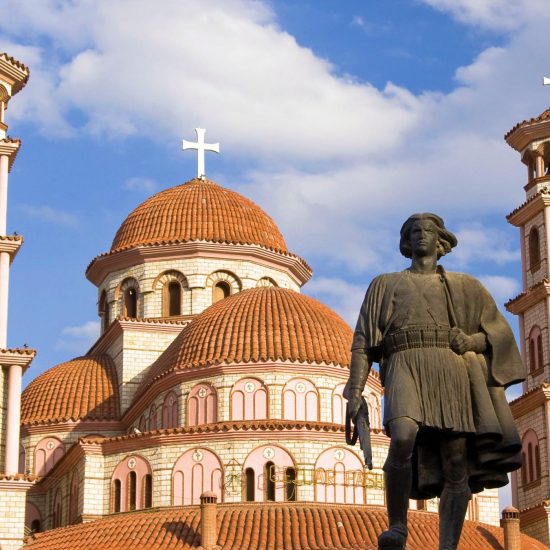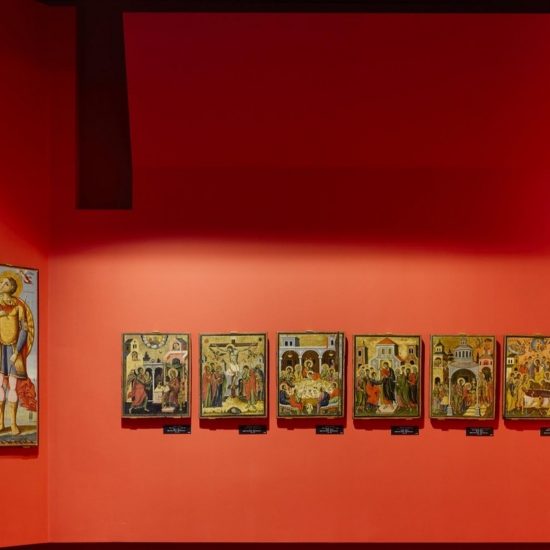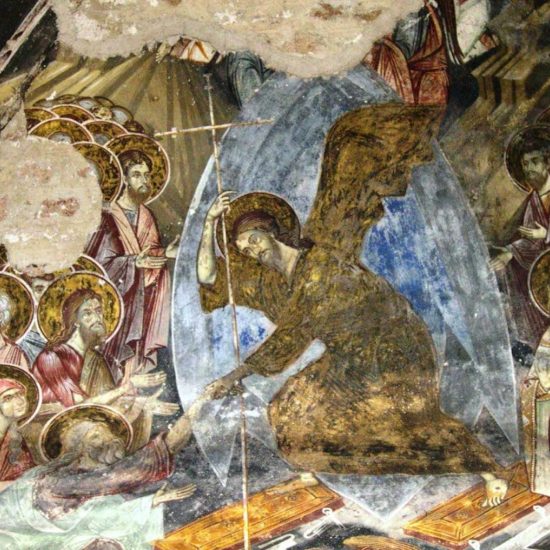Pogradeci
You enter the region of Pogradec via the national highway where the road from Macedonia crosses Qafë Thanë. This crossroad offers picturesque views of Lake Ohrid, a true pearl nestled between Mali i Thatë (the Dry Mountain) to the east and the Mokra highland to the west. A little further down, you might stop at the Lin peninsula and in the village of the same name just 25 km outside of Pogradec. It is said that in ancient times, this was the favorite holiday destination of the Roman Emperor Justinian’s parents. In addition to the enchanting views, one can also discover the mosaics of Lin, dating back to the 7th-6th centuries B.C. This ancient artwork exhibits an amazing ensemble of zoomorphic, floral, and geometric decorations resembling those in ancient Durrës. The road to Pogradec passes along the shore of the tectonic Lake Ohrid, the deepest lake in the Balkans (285 m). This 2-4 million year old lake is under UNESCO protection due to its unique value and is home 17 species of aquatic animals, 70% of which are native and 30% migrant. The sponge of Ohrid is found only here and in Lake Baikal. By the lakeside you will find an array of restaurants, clubs, and comfortable hotels. You must not miss a taste of the traditional fish dishes, especially the baked speckled trout (Koran in Albanian), as well as the famous pickles. You might also sample the various wines on offer, but don’t miss the traditional unique wine of Buti, or the famous Perla and Moskat raki of Pogradec. The city of Pogradec was settled in the Neolithic period, and it later became home to the Illyrian Enkelejdë and Desaretë clans, who built the Castle of Pogradec on a hill at 870 m above sea level. The city, with its mild climate, lends itself to year-round visits. Before leaving Pogradec don’t miss Drilon and Tushemisht, just 4-5 km south of the city. The Drilon waters form a small lake, surrounded by beautiful greenery that makes the area and the nearby village of Tushemisht a unique oasis of beauty and tranquility. The region of Pogradec is rich in striking and distinctive natural and historical monuments. You might visit the natural monument, the Rock of Kamje, which is located in the commune of Dardhas (on the way from Pogradec to Korça, near the village of Osnat). It is 70 m high and suddenly rises out of the surrounding terrain like a “ship sailing in a sea of green.” The archaeological site and Monumental Graves of Selca lie 30 km away from Pogradec. The monuments here date back to the 4th century B.C. and the five monumental stone graves are found in very few places elsewhere in the Balkans.
Korça
The next surprise after the exceptional city of Pogradec is the city of Korça, one of the biggest urban centers in Albania. During springtime, the soft fragrance of sturgeon flowers fills the main avenue, while in winter you can enjoy a quiet stroll under the snow covered trees. In 1887, the first Albanian school opened in Korça. During the First World War, French forces took control of the city and it became the Autonomous Region of Korça. In 1917, the French Lyceum (one of the most notable schools in Albania) opened. Besides its notable history, Korça’s traditional architecture, with its villa-like houses encircled by banisters and flowery gardens are worth noting. The zone between Republika and Shën Gjergji boulevards is very interesting: here, the Medieval Art Museum and Prehistoric Museum are housed in two traditional Korça buildings, displaying nearly 1,200 artifacts from the prehistoric, Hellenic, Roman, and early-Byzantine eras. Other points of interest include the historic house of the master artist Vangjush Mio and the Museum of the Bratko Collection, opened in 2003. You might want to also visit the bazaar (dating from the turn of the 20th century), the Mosque of Iliaz Bej Mirahori (the oldest historical monument in the City, dating back to 1484), and the Cathedral Ngjallja e Krishtit (Resurrection of Christ), one of the biggest cathedrals in the Balkans. The city is known for its characteristic songs, called serenades, which are played with guitar. In the city taverns you can sample local dishes (be sure to not miss lakror with onion and tomato as well as tava e korminës), and don’t forget the Carnival Festival, the biggest celebration of its kind in all of Albania.
Voskopoja
Voskopoja was historically one of the most important urban Balkan centers, dating back to 1330. It reached its golden age in 1794, with a population numbering 30,000 and contacts as far as Leipzig, Budapest, Venice, and Vienna. The city was also home to 27 churches, an academy, a library, and the first printing house in the Balkans (in 1720). Pay a visit to the Monastery of Shën Prodhomi, Church of Shën Kolli (1721), Church of Shën Thanasi, Fjetja e Shën Marisë Church, and the Church of Shën Ilia, which houses pictures of famous Albanian iconographers, such as David Selenicasi and the Zografi brothers from Korça, who also worked in the Saint Mountain of Athos, in Halkidiki, Greece. In addition to its invigorating climate and pine-scented air, Voskopoja offers comfortable hotels and private houses for family tourism as well as a natural ski slope for skiing enthusiasts.
Dardha
Another unforgettable mountain spot is the village of Dardha, 20 km southeast of Korça, at 1,350 m above sea level. There is snow during the winter months, the air is crystal clear, and the water of the village’s many natural fountains is pure and invigorating. Look out for the unique women’s folk costumes dominated by black and red (the colors of the national flag), visit stone houses that offer hospitality to travelers, and don’t miss a taste of the traditional plum raki and the lakrori në saç (a traditional pie made with cabbage between two sheets of dough, and baked in a wood fired oven).
You enter the region of Pogradec via the national highway where the road from Macedonia crosses Qafë Thanë. This crossroad offers picturesque views of Lake Ohrid, a true pearl nestled between Mali i Thatë (the Dry Mountain) to the east and the Mokra highland to the west. A little further down, you might stop at the Lin peninsula and in the village of the same name just 25 km outside of Pogradec. It is said that in ancient times, this was the favorite holiday destination of the Roman Emperor Justinian’s parents. In addition to the enchanting views, one can also discover the mosaics of Lin, dating back to the 7th-6th centuries B.C. This ancient artwork exhibits an amazing ensemble of zoomorphic, floral, and geometric decorations resembling those in ancient Durrës. The road to Pogradec passes along the shore of the tectonic Lake Ohrid, the deepest lake in the Balkans (285 m). This 2-4 million year old lake is under UNESCO protection due to its unique value and is home 17 species of aquatic animals, 70% of which are native and 30% migrant. The sponge of Ohrid is found only here and in Lake Baikal. By the lakeside you will find an array of restaurants, clubs, and comfortable hotels. You must not miss a taste of the traditional fish dishes, especially the baked speckled trout (Koran in Albanian), as well as the famous pickles. You might also sample the various wines on offer, but don’t miss the traditional unique wine of Buti, or the famous Perla and Moskat raki of Pogradec. The city of Pogradec was settled in the Neolithic period, and it later became home to the Illyrian Enkelejdë and Desaretë clans, who built the Castle of Pogradec on a hill at 870 m above sea level. The city, with its mild climate, lends itself to year-round visits. Before leaving Pogradec don’t miss Drilon and Tushemisht, just 4-5 km south of the city. The Drilon waters form a small lake, surrounded by beautiful greenery that makes the area and the nearby village of Tushemisht a unique oasis of beauty and tranquility. The region of Pogradec is rich in striking and distinctive natural and historical monuments. You might visit the natural monument, the Rock of Kamje, which is located in the commune of Dardhas (on the way from Pogradec to Korça, near the village of Osnat). It is 70 m high and suddenly rises out of the surrounding terrain like a “ship sailing in a sea of green.” The archaeological site and Monumental Graves of Selca lie 30 km away from Pogradec. The monuments here date back to the 4th century B.C. and the five monumental stone graves are found in very few places elsewhere in the Balkans.
Korça
The next surprise after the exceptional city of Pogradec is the city of Korça, one of the biggest urban centers in Albania. During springtime, the soft fragrance of sturgeon flowers fills the main avenue, while in winter you can enjoy a quiet stroll under the snow covered trees. In 1887, the first Albanian school opened in Korça. During the First World War, French forces took control of the city and it became the Autonomous Region of Korça. In 1917, the French Lyceum (one of the most notable schools in Albania) opened. Besides its notable history, Korça’s traditional architecture, with its villa-like houses encircled by banisters and flowery gardens are worth noting. The zone between Republika and Shën Gjergji boulevards is very interesting: here, the Medieval Art Museum and Prehistoric Museum are housed in two traditional Korça buildings, displaying nearly 1,200 artifacts from the prehistoric, Hellenic, Roman, and early-Byzantine eras. Other points of interest include the historic house of the master artist Vangjush Mio and the Museum of the Bratko Collection, opened in 2003. You might want to also visit the bazaar (dating from the turn of the 20th century), the Mosque of Iliaz Bej Mirahori (the oldest historical monument in the City, dating back to 1484), and the Cathedral Ngjallja e Krishtit (Resurrection of Christ), one of the biggest cathedrals in the Balkans. The city is known for its characteristic songs, called serenades, which are played with guitar. In the city taverns you can sample local dishes (be sure to not miss lakror with onion and tomato as well as tava e korminës), and don’t forget the Carnival Festival, the biggest celebration of its kind in all of Albania.
Voskopoja
Voskopoja was historically one of the most important urban Balkan centers, dating back to 1330. It reached its golden age in 1794, with a population numbering 30,000 and contacts as far as Leipzig, Budapest, Venice, and Vienna. The city was also home to 27 churches, an academy, a library, and the first printing house in the Balkans (in 1720). Pay a visit to the Monastery of Shën Prodhomi, Church of Shën Kolli (1721), Church of Shën Thanasi, Fjetja e Shën Marisë Church, and the Church of Shën Ilia, which houses pictures of famous Albanian iconographers, such as David Selenicasi and the Zografi brothers from Korça, who also worked in the Saint Mountain of Athos, in Halkidiki, Greece. In addition to its invigorating climate and pine-scented air, Voskopoja offers comfortable hotels and private houses for family tourism as well as a natural ski slope for skiing enthusiasts.
Dardha
Another unforgettable mountain spot is the village of Dardha, 20 km southeast of Korça, at 1,350 m above sea level. There is snow during the winter months, the air is crystal clear, and the water of the village’s many natural fountains is pure and invigorating. Look out for the unique women’s folk costumes dominated by black and red (the colors of the national flag), visit stone houses that offer hospitality to travelers, and don’t miss a taste of the traditional plum raki and the lakrori në saç (a traditional pie made with cabbage between two sheets of dough, and baked in a wood fired oven).







